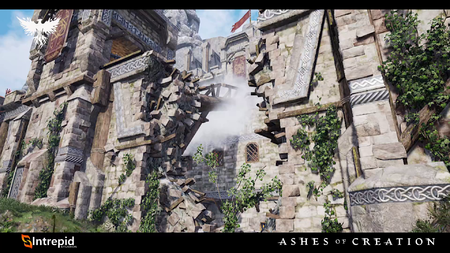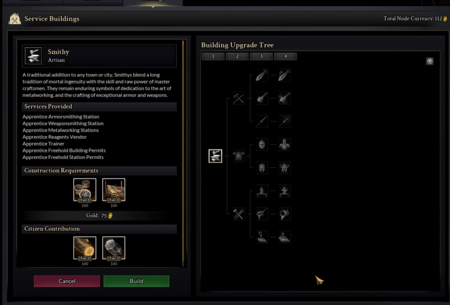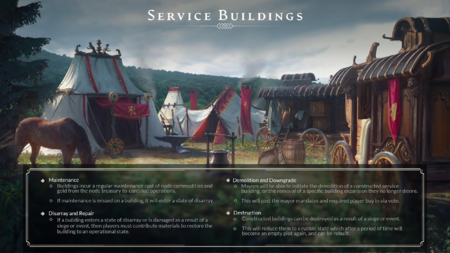Service building upkeep
Service buildings incur a regular maintenance cost of node commodities and gold from the node treasury in order to continue operations.[1][3]
- Building maintenance is auto-paid from the treasury in order of the most valuable buildings first.[1][3]
- If maintenance is not paid, or a building is damaged as the result of an event or siege, the building will enter a state of disarray.[1][3] Any NPCs or services offered by that building will not be available until the building is repaired.[4][5]
- Players must contribute materials to repair disarrayed buildings and restore them to an operational state.[1][3][6][5][7]
- Larger more advanced buildings will require more resources to repair them. In-node housing will likely require the least resources to repair.[8]
- Previously building repair was restricted to node-citizens.[5][7]
Node building destruction

You could be more precision oriented in the decision to attack a city. Let's say it's a rival node that's trying to reach a node stage five or something and you want to disable their ability for the religious system to progress so you target the temple during the attack, or you want to disable their scholars academy from reaching a higher level so that your nodes can; or you want to disable multiple buildings that allow for experience and quests to be undertaken by its citizenship, which prevents them from keeping up in pace of experience gained with your node. These can be more precision oriented and don't have to effectualize an actual takeover of the node.[10] – Steven Sharif
Node buildings (including player housing) have hit points and can be damaged or destroyed by different systems.[6][5]
- NPC-driven events that are a response to story arcs or node atrophy.[6]
- Node sieges and node wars.[6]
- Attackers may not be capable of destroying a node during a siege. Instead they may carry out precision attacks to disable specific service-oriented buildings within the node. These buildings can be targeted with siege weapons and bombs.[10]
- Hazardous events such as tornadoes or hurricanes.[11][6]
- Mayors have the ability to demolish constructed node buildings. This will have a node mandate cost and will require player buy-in via a vote.[1][3]
- Mayors will also have the ability, if they want, to demolish constructed buildings. So if they if they so choose they can destroy a building if they don't think it's needed anymore. But this will have mandate cost and a player buy-in votes. So we want to make sure that [the] mayor can't just go and blow up the whole node if they're trying to grief or something. So this is very important and impactful decision.[1][3] – John Collins
If building maintenance is not paid, or a building is damaged as the result of an event or siege, the building will enter a state of disarray.[1][3] Any NPCs or services offered by that building will not be available until the building is repaired.[4][5]
- Players must contribute materials to repair disarrayed buildings and restore them to an operational state.[1][3][6][5][7]
If a node siege is successful, or if buildings otherwise take significant damage, they are destroyed and appear as rubble on the plot they occupied.[1][3][6]
- Node governments must clear any rubble on plots before any buildings can be reconstructed. Any prerequisites for the building reconstruction must be satisfied beforehand.[6]
- Buildings also live within a prerequisite system. So in order to build down the tech tree of what these buildings provide, as the node grows larger to access stronger building types, you may get a kink in that chain if it's destroyed and you'll have to stand that back up in order to support the service again.[6] – Steven Sharif
- If the node is destroyed by a node siege, the debris field will contain spoils that are lootable by attackers or defenders.[12][13][14][5][15][16]
- Player housing that is destroyed during a node siege can no longer be sold.[17] Furnishing and decorations are retained and can be placed again later.[17][18][19]
Service building expansions

Default buildings they specialize as they expand. So this isn't like a traditional skill tree, it's exclusionary, more like a tech tree. So selecting the next upgrade for it will lock out the other two paths. So as you get better with the building it will continue to narrow, which allows lots of nodes to carve out lots of niches in the world.[21] – Chris Justo
Service buildings are upgraded by expansions, which are unlocked through the placement of passive service buildings.[1][2]
- Service building expansions allow buildings to be specialized via a tech tree, such as moving from a generalized Blacksmithing building to an Armor smithing building, then finally toward a building that specializes in Plate armor.[21][2][6]
- To upgrade your building, you choose expansions, you build passive buildings to allow you to unlock those expansion slots and just a little- basically specialize your service building down a path; and the building specialization will narrow down a specific path. So you might start as a generalized Blacksmith building and then you'll specialize towards maybe armorsmithing, and then towards specifically, like plate armor through the expansion tree.[2] – John Collins
- Building expansions unlock higher tier workstations at the cost of dedicating service building plots. Lower stage nodes can achieve higher tier service buildings by dedicating a majority of their service plots to that path. Mayors decide how to specialize their node. Once they choose certain things they won't be able to choose other things.[22][23][24]
- The pathway of upgrades is exclusionary. So when I choose a path down a particular building type in order to reach a tier five benefit: when I eventually reach a higher stage, or even if I'm lower stage and want to dedicate a majority of my service plots toward one particular crafting building; like I may get a very top tier workstation as a result, even if I'm still a Village node. It's like I'm the village node that makes the T5 swords because I've dedicated all of my plots to that.[22] – Steven Sharif
- Vassal nodes can benefit from the types of service buildings present in their regent node.[25]
- You might have a parent node, or a Regent node, that has a vassalship over your node and you're getting benefits conferred to you through either the prerequisite of the building types that you can construct as well to make a bit more headway there.[22] – Steven Sharif
Buy orders

Buy orders are instrumental in the activities that a node participates in.[26] – Steven Sharif

We're gonna build a Forge today, or a Smithy- we renamed it: it's not a forge anymore- and we need bins of stone for it.[27] – Chris Justo
Buy orders are the primary way for a node to generate node commodities that can be spent on construction, upgrades, and maintenance of node service buildings.[1][28]
- Mayors initiate buy orders using gold from the node treasury.[1][28][29] The mayor can adjust the parameters of buy orders:
- How many commodities are being requested.[1][28]
- How long the buy order is active.[1][28]
- The raw materials or crafting materials required to complete the buy order.[30][1][28] Final goods are not used to complete buy orders.[30]
- How much players are rewarded.[1][28]
- When selecting specific types of buy orders that require certain material components in order to fulfill, you will have a wide array of material choices to make: either those that are relevant locale to your node placement or those that are across the world; and there is a variable in payment that the mayor has access to in setting and how they'll be rewarding players. So you need to make sure that you're incentivizing players who are making those large transits across the world to actually take that risk and bring those materials to you.[31] – Steven Sharif
- Players are rewarded with bound node currency and node reputation for fulfilling buy orders.[26][1][28]
- Once a material gets sunk into the buy order, the player receives the benefit of the node currency, which right now is a bound currency that's used to purchase a number of different types of vendorable items that exist within nodes.[26] – Steven Sharif
- If a mayor does not create buy orders, they will auto-populate after a set period of time based on node activities.[32]
- If the mayor is not making these decisions, buy orders will populate based off of activities that the node have available to them after a set period of time. So that the bad faith mayor is not depleting the node potentially of its resources that players can still interact with.[32] – Steven Sharif
- Node citizens participating in buy orders will generate mandates for their node.[33]
- Players will be able to view buy orders that are listed at nodes around the world.[34]
- Those of you who are traders and are interested in actually capitalizing on the supply and demand of nodes and their competing interests and what they're trying to accomplish will have an opportunity to move those goods around the world: Take that risk potentially, but receive a high reward as a result.[34] – Steven Sharif
- Buy orders are distinct from mayoral commissions.[35]
- A buy order is strictly material-based and you don't accept a buy order and then go do it. It is something that you can just check your node UI or you can check the nodes around you to see what they have active and you can just go do it and come back; and participate or fulfill these buy orders. Whereas, a commission is- a mayoral commission is more like a quest. It's something you pick up and then it tracks your activity while you have it.[35] – Chris Justo
Visuals
See also
References
- ↑ 1.00 1.01 1.02 1.03 1.04 1.05 1.06 1.07 1.08 1.09 1.10 1.11 1.12 1.13 1.14 1.15 1.16 1.17 1.18 Blog: Development Update with Village Node.
- ↑ 2.0 2.1 2.2 2.3 2.4 Livestream, August 31, 2023 (50:25).
- ↑ 3.0 3.1 3.2 3.3 3.4 3.5 3.6 3.7 3.8 Livestream, August 31, 2023 (57:23).
- ↑ 4.0 4.1 Interview, July 9, 2023 (1:32:45).
- ↑ 5.0 5.1 5.2 5.3 5.4 5.5 5.6 Interview, July 8, 2020 (57:46).
- ↑ 6.0 6.1 6.2 6.3 6.4 6.5 6.6 6.7 6.8 6.9 Livestream, March 31, 2022 (1:13:00).
- ↑ 7.0 7.1 7.2 Livestream, November 22, 2019 (17:59).
- ↑ Interview, July 8, 2020 (59:38).
- ↑ Livestream, October 31, 2019 (36:20).
- ↑ 10.0 10.1 Livestream, November 22, 2019 (16:56).
- ↑ Forums - Livestream Q&A 2022-08-26.
- ↑ Interview, July 9, 2023 (1:36:24).
- ↑ Livestream, October 14, 2022 (52:31).
- ↑ Podcast, September 29, 2021 (14:21).
- ↑ Livestream, April 30, 2020 (1:14:44).
- ↑

- ↑ 17.0 17.1 Livestream, June 26, 2020 (1:02:12).
- ↑ Livestream, July 18, 2017 (40:14).
- ↑ Livestream, November 17, 2017 (47:10).
- ↑ Video, August 31, 2023 (46:54).
- ↑ 21.0 21.1 21.2 Video, August 31, 2023 (34:37).
- ↑ 22.0 22.1 22.2 Livestream, August 31, 2023 (52:56).
- ↑ Livestream, January 20, 2018 (38:17).
- ↑ Livestream, May 19, 2017 (33:57).
- ↑ Livestream, August 31, 2023 (54:44).
- ↑ 26.0 26.1 26.2 Livestream, August 31, 2023 (1:01:10).
- ↑ 27.0 27.1 Video, August 31, 2023 (5:04).
- ↑ 28.0 28.1 28.2 28.3 28.4 28.5 28.6 Livestream, August 31, 2023 (59:43).
- ↑ Interview, July 8, 2020 (1:04:05).
- ↑ 30.0 30.1 Livestream, August 31, 2023 (1:06:01).
- ↑ Livestream, August 31, 2023 (1:02:35).
- ↑ 32.0 32.1 Livestream, August 31, 2023 (1:02:23).
- ↑ Livestream, August 31, 2023 (1:04:00).
- ↑ 34.0 34.1 Video, August 31, 2023 (12:55).
- ↑ 35.0 35.1 Livestream, August 31, 2023 (1:04:14).

